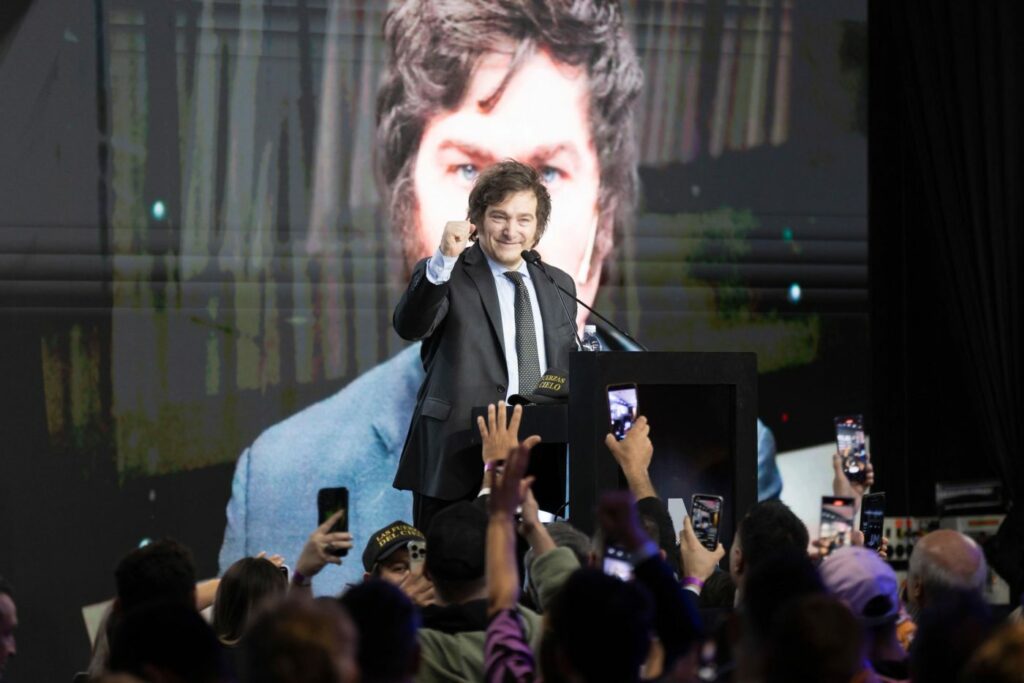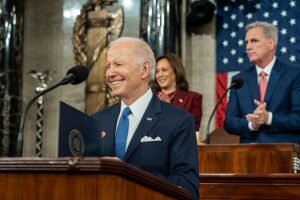Milei Takes Argentina: An Emblem of Shifting Tides in Latin American Political Representation
Milei stands out through inflammatory statements and a very purposeful outsider anti-establishment framing. He positions himself against the “caste” of the Argentine political system. This positioning, more than anything, defines his electoral success.

The candidate for President for La Libertad Avanza (LLA), Javier Milei, headed an event organized by the Gastronomic Union (UTHGRA), which supports his candidacy. Buenos Aires, Argentina on September 22, 2023. Image Credit: Esteban Osorio/Sipa USA/Alamy Live News
On Nov. 19, ultra-right-wing and self-described anarcho-capitalist candidate Javier Milei took the Argentine presidential elections with 55,69% of the total votes, beating out Peronist opposition Sergio Massa by nearly 3 million votes. It was a complete landslide — Milei had the majority in the capital city of Buenos Aires and 20 out of 23 Argentine provinces. Across Latin America, Milei’s electoral triumph has been met with widespread concern and uncertainty in the face of the president-elect’s extreme proposals for Argentina’s future. Despite this, Milei’s win is not surprising to those paying attention to Argentina and the most recent supercycles of presidential elections in Latin America.
Milei’s success is emblematic of larger trends around political representation in the region and not an isolated instance. Daniel Zovatto, International IDEA Regional Director for Latin America and the Caribbean, identifies seven broad trends across Latin American elections during and since COVID-19: a “punishing” vote against current governments; shorter political cycles (i.e., fewer re-elections); hyper-polarization; risk of populism; results defined in the second round; high political fragmentation; and “polluted” chains of information. Arguably, the most recent election in Argentina hits every single one of these points — in particular, the “punishing” vote and intense political polarization contributed to Milei’s success, which speaks to the broader political climate in Latin America as a whole.
The Argentine president-elect’s policy proposals stand out even among recent extreme right-wing governments in the region. Milei’s plans for Argentina are many, each more surprising than the last. To name a few: mass and complete privatization of public economic institutions; extreme cuts to public spending (15%) through mass layoff of state workers and public service subsidies; the dollarization of the economy; the elimination of 10 out of 18 national Ministries (including the Ministries for Health, Education, Environment and Sustainability, Social Development, and more); and the “explosion” of the Argentine Central Bank. Milei’s policies follow an extreme libertarian perspective.
These proposals are extremely controversial, especially in the context of a struggling economy riddled with record-high inflation and increasing disparity between salaries and living costs. Pablo Anino points out the infeasibility of many of Milei’s economic proposals, such as a 15% cut in government spending, where the proposed mass layoffs and subsidy reductions would realistically add up to less than 1% of the Argentine GDP. Cuts to public service subsidies would increase service prices which would be actively harmful to the majority of the Argentine population, given the rising cost of living and diminishing wages. The mere suggestion of national dollarization and the abandonment of the peso caused a massive currency crash just this August. These and other considerations have led many political analysts to conclude that the average Argentine citizen has effectively voted against their own economic and political self-interest. The question then naturally arises: why?
The highly inflammatory nature of Milei’s political campaign is key to answering this question. We return to Daniel Zovatto’s fourth trend on the electoral supercycle: the rise of populism in electoral politics. Milei has taken a strong character-based approach to campaigning, a method now tried and tested by ‘personality’ political figures such as the United States’ Trump and Brazil’s Bolsonaro (whom Milei names explicitly as “inspirations”). His statements are not only purposefully controversial — such as his support of human organ sales as “just another market” and uncertain response to whether he supports the sale of children — but outright gimmicky. He uses eye-catching symbols, such as a giant dollar sign and a chainsaw at political rallies, representing his intention to “slash down” the government. Milei stands out through inflammatory statements and a very purposeful outsider anti-establishment framing. He positions himself against the “caste” of the Argentine political system. This positioning, more than anything, defines his electoral success.
Against the backdrop of a destroyed political status quo and a demoralized Argentine public, Milei’s outsider framing positions him with the people, as opposed to the wider positioning of the political system as against them. Milei becomes the reigning symbol of the new political order to a national population desperate for radical change. The vote for Milei is fundamentally tinted with hope for the new, as well as “punishing” spite for the old. His material proposals, which radically deviate from the Argentine political reality, are less important than Milei’s staunch anti-establishment stance.
Milei’s success in Argentina cannot be observed in isolation. There is a broad air of exasperation towards relatively moderate governments across Latin America, which lends itself to the repeated appeal and success of the outsider right-wing, populist framing in the region.
The guise of the new right-wing approach to politics is solidly rooted in very old political traditions in Latin America. With Milei and his government, as with Bolsonaro in Brazil, there is a strong revival of right-wing dictatorship-era rhetoric. Milei’s Vice President-elect, Victoria Villarruel, has close ties to the Argentine military and long since has campaigned against projects of reconciliation for the 30,000 disappeared victims of the Argentine military dictatorship. Most recently, Villarruel argued for the repurposing of the Escuela de Mecanica de la Armada (ESMA) Museum and Site of Memory — which during the dictatorship functioned as a major center for detention and torture of political prisoners and the disappeared — claiming that “the field of human rights has been a real black hole” for state subsidies and funding. In opposition, the famous Madres de la Plaza de Mayo –– the mothers and grandmothers of disappeared victims –– have declared a “state of alert and mobilization” in defense of Argentine human rights against the Milei-Villarruel formulation, which they see as openly “negationist” towards the genocidal dictatorship.

The old politics behind Milei’s government are also rooted, ironically, in the very “establishment” that it so staunchly opposes. Despite positioning himself against the political status quo, Milei abandoned this ideal immediately after the first round of elections, when he made concessions to former right-wing president Mauricio Macri and his political circle, who are largely associated with the collapse of the Argentine economy in recent years. Macri, in turn, offered Milei his support against Sergio Massa in the second round of elections, encouraging voters who initially supported Macri’s faction (under Patricia Bullrich) in the first round to turn instead to Milei in the second. This support was a decisive factor in Milei’s success. Among other members of Macri’s circle who now make up much of Milei’s office, Bullrich herself is Milei’s new Minister of Security.
There is much of the old in the new of Milei’s office, not only in its ties to and negationism of Argentina’s violent military dictatorship but also in its connections to a past right-wing government which participates in the status quo that the new supposedly abhors. Even his giant dollar and chainsaw-wielding gimmick harkens back to much older right-wing Latin American political characters, such as Jânio Quadros’ giant broom in 1960 (a symbol for “sweeping up” the government, just as Milei saws it down).
The likelihood of some of the more extreme policies tied to Milei’s “anti-establishment” gimmick being put into practice has also been highly debated — as with the 15% cut in public spending or the dollarization of the Argentine currency. However, the mere opening of political representation to such radical proposals, from “exploding” the Central Bank to the elimination of historical monuments to human rights abuses, speaks to a broad political shift towards extremist right-wing politics in Argentina and in Latin America.
This shift does not happen in a vacuum. It comes about as a response to the region’s diminishing weight of more moderate or progressive alternatives. This is clear in Argentina, where Milei framed his political campaign against an existing status quo. That status quo matters, and Sergio Massa, the current Minister of Economy amid a debilitating economic crisis, embodies it. Massa’s campaign deliberately framed itself as the “lesser evil” against Milei’s radical character. Rather than defining its political campaign according to its own independent proposals, Massa’s faction became the broad “alternative” for anyone opposing Milei’s ideas. This framing reduces the electoral debate to a choice between a continuation of failing moderate politics or deliberately daring and eye-catching extremist proposals. It relies entirely on the idea that Argentine voters will choose their present condition over radical change. Clearly, this was not a winning bet.
This approach has worked elsewhere — most recently, in last year’s Brazilian elections, where Lula beat out former-president Bolsonaro by a mere 1.6% of national votes. But this was only the case after Bolsonaro’s 4-year term, which left 700,000 dead during the COVID-19 pandemic –– the second highest mortality rate in the world –– and a complete drainage of national funds. Even post-re-election, Lula’s moderate leftist government and like-leaning governments in Chile (under Boric) and Colombia (under Petro) face intense opposition from right-wing political majorities. The “lesser of two evils” framing in opposition to a rise in radical right-wing representation is therefore highly questionable. Due to its complacency to the many problems of Latin American political realities, a “moderate” political strategy such as Massa’s waters down the electoral process. It allows for the rise of radical political characters such as Milei. More broadly, this process amounts to a concerning deterioration of democratic political choice in the electoral question of political representation.
Rather than making a conclusive argument about the nature of electoral shifts in Argentina, I prompt readers to understand these shifts in the context of the larger Latin American political reality. The most recent turn of events in Argentina, which can be understood as either or both Milei’s success and Massa’s failure, is part of a wider regional environment. This is not to say that Argentina’s election is not full of its own particularities unique to its national context. Latin American realities are not interchangeable. Just as understanding Latin America as a region helps us contextualize national movements, following events in Argentina allows us to better understand the international. That is what Argentina can show us.

Carolina Xavier (she/her) is a first-year MA student in International Relations, focusing on International Law. She graduated from the University of Toronto in 2023 with an Honors Bachelor of Arts degree in International Relations, emphasizing International Law & Human Rights. Over the past three years, she has worked with a political consulting firm in Brazil and at the Brazilian National Congress. Her research primarily revolves around Latin American politics and international relations, exploring how the arts and cultural spheres intersect with political and social movements. In her free time, Carolina enjoys listening to music, reading, drawing, and discovering unique cafés in the city.






